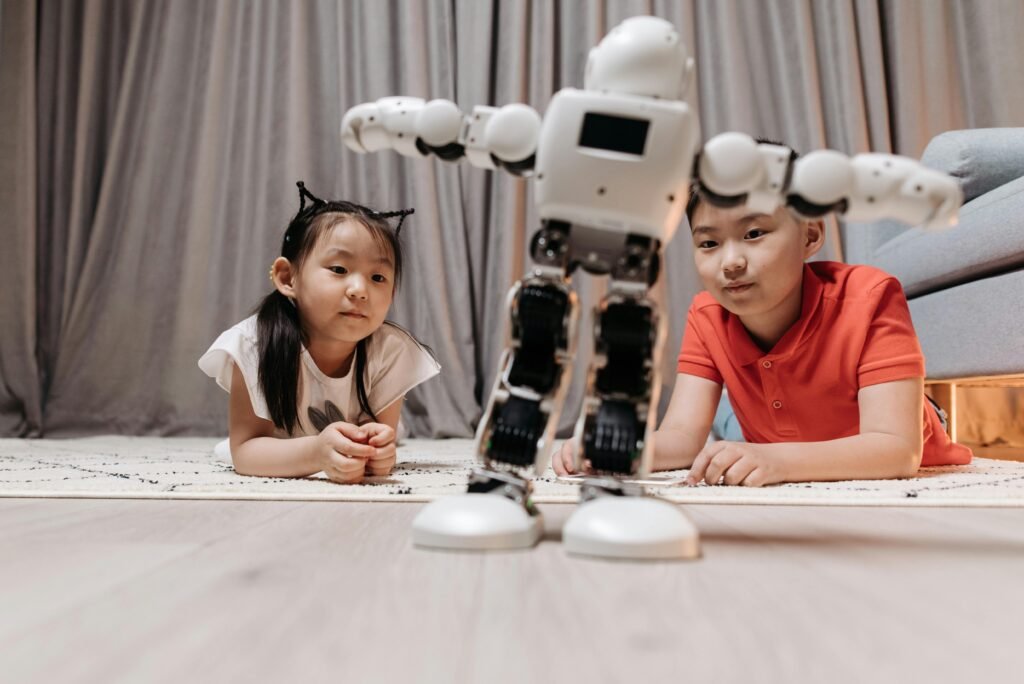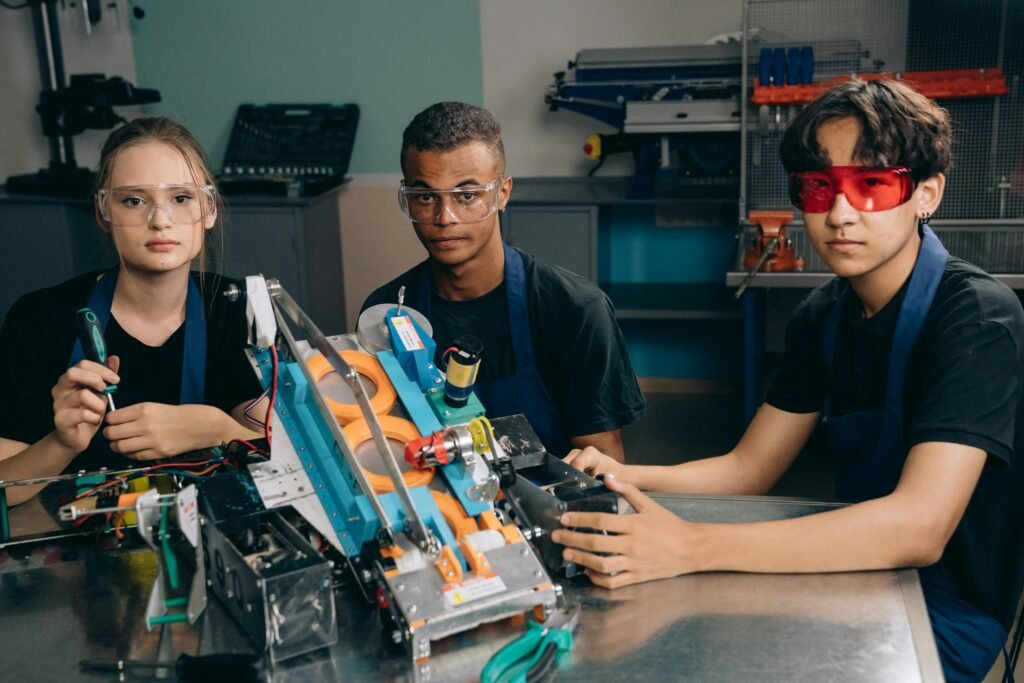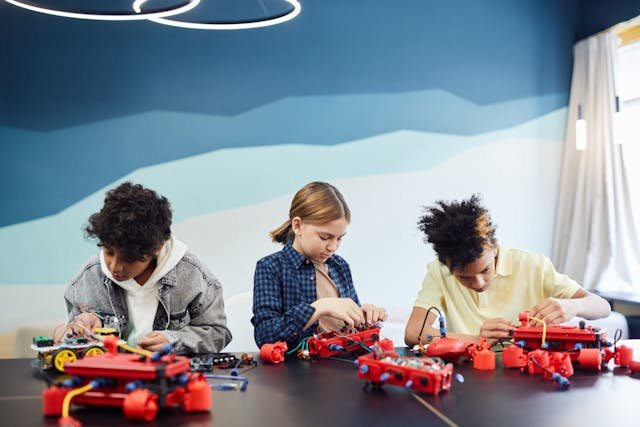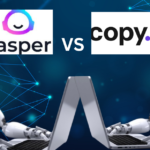Imagine a classroom where students learn coding, engineering, and AI by building and programming robots. It sounds like science fiction, right? Not anymore. Educational robots are revolutionizing the way we teach and learn, making STEM (Science, Technology, Engineering, and Mathematics) subjects more engaging, interactive, and accessible than ever before. Whether you’re a parent, teacher, or hobbyist, this guide will introduce you to some of the best educational robots available today, helping you choose the perfect tools to inspire young minds.

Why Educational Robots Matter
Educational robots are more than just toys—they are powerful tools for learning. By combining hands-on activities with cutting-edge technology, these robots help students develop critical skills that are essential for the future. Here’s why they matter:
Educational Robots Skill Development
Educational robots are powerful tools for skill development, offering students hands-on opportunities to build essential abilities that extend far beyond the classroom. One of the most significant benefits is the enhancement of problem-solving and critical thinking skills. When students work with robots, they are often tasked with challenges like programming a robot to navigate a maze or complete a specific task. These activities require them to break down complex problems into smaller, manageable steps, analyze data, and test their solutions. For example, if a robot fails to follow a designated path, students must troubleshoot the issue, identify the root cause, and adjust their code or design accordingly. This process not only sharpens their analytical skills but also teaches resilience and adaptability, as they learn to persevere through trial and error. Such problem-solving experiences are invaluable, preparing students to tackle real-world challenges with confidence and creativity.
Educational Robots Engagement
Educational robots are transforming the way students interact with learning by making it dynamic, interactive, and fun. Unlike traditional teaching methods, which can sometimes feel monotonous, robots captivate students’ attention through hands-on activities and real-world applications. For example, programming a robot to navigate a maze or complete a task turns abstract concepts into tangible experiences, keeping students actively involved in the learning process. Additionally, many robots incorporate gamified elements, such as challenges, competitions, and rewards, which further boost motivation and make learning feel like play. This heightened engagement not only helps students retain information better but also fosters a genuine interest in STEM subjects. By turning passive learners into active participants, educational robots create an environment where curiosity thrives and students are excited to explore new ideas.
Future-Readiness
In a world increasingly shaped by automation, artificial intelligence, and advanced technologies, preparing students for the future has never been more critical. By engaging with tools that teach coding, problem-solving, and critical thinking, students develop future-proof skills that are essential for thriving in tomorrow’s workforce. For instance, learning to program a device or troubleshoot technical issues not only builds technical expertise but also fosters adaptability and resilience—qualities that are invaluable in a rapidly evolving job market.
Moreover, hands-on experiences with innovative technologies help students understand real-world applications, from AI-driven systems to automated processes, giving them a competitive edge in STEM-related careers. By equipping students with these skills early on, we empower them to navigate the challenges of the future with confidence and creativity.
Types of Educational Robots
Educational robots come in various forms, each designed for different age groups, skill levels, and learning objectives. Below, we’ve categorized the top types of educational robots to help you find the perfect fit.
Kits for Beginners
Getting started with robotics doesn’t have to be intimidating—thanks to beginner-friendly robotics kits, even young learners and first-time enthusiasts can dive into the world of coding, engineering, and innovation. Designed with simplicity in mind, these kits often come with easy-to-follow instructions, user-friendly interfaces, and pre-assembled components, making them perfect for those taking their first steps into robotics. Whether it’s building a basic robot or programming it to perform simple tasks, these kits provide a fun and engaging way to learn foundational STEM concepts. Let’s explore some of the best options for beginners and how they can spark a lifelong passion for technology and creativity.

Examples:
mBot Robot Kit:
The mBot Robot Kit is an excellent choice for beginners, offering a perfect blend of simplicity and functionality to introduce users to the world of coding and robotics. Designed with a user-friendly drag-and-drop programming interface, this kit allows even young learners to create and control their own robotic projects with ease. For example, users can program the mBot to follow lines, avoid obstacles, or even play games, making learning both interactive and fun.
Additionally, its modular design and compatibility with various sensors and add-ons provide room for growth, ensuring that users can gradually advance their skills as they gain confidence. By combining accessibility with versatility, the mBot Robot Kit serves as an ideal starting point for anyone eager to explore the exciting possibilities of robotics and programming.
LEGO-Compatible Robotics Kit:
The LEGO-Compatible Robotics Kit combines the creativity of LEGO building with the excitement of robotics, making it a fantastic choice for beginners of all ages. With its familiar LEGO components, users can easily assemble and customize their robots, while the intuitive programming interface allows them to bring their creations to life.
For instance, users can program their robots to move, respond to sensors, or even complete challenges, blending play with practical learning. Additionally, the kit’s compatibility with standard LEGO pieces encourages endless customization, enabling users to design unique robots that reflect their imagination. By merging the fun of LEGO with the fundamentals of coding and engineering, this kit provides a seamless and engaging introduction to the world of robotics.
Use Cases:
– Introducing kids to basic robotics and programming.
– Encouraging creativity through hands-on building.
Coding and Programming Robots
In today’s digital age, coding and programming are essential skills, and what better way to learn them than through interactive robots? Coding and programming robots are designed to make learning these skills engaging and accessible, turning complex concepts into hands-on, fun experiences. Whether it’s using block-based coding for beginners or diving into text-based programming for advanced learners, these robots offer a dynamic way to understand how software and hardware work together. From navigating mazes to performing tasks, these tools bring code to life, helping students develop logical thinking, problem-solving, and creativity. Let’s explore how these robots are making coding and programming not just educational, but also exciting and inspiring.

Examples:
Programmable Robot Ball:
The Programmable Robot Ball is a versatile and engaging tool that brings coding to life through play. Designed with a simple, app-based interface, users can program the ball to navigate mazes, play games, or even respond to voice commands, making it an excellent choice for beginners and young learners. For example, its block-based coding system allows users to create commands by dragging and dropping icons, providing an intuitive way to learn programming basics. Additionally, the ball’s durable design and interactive features, such as LED lights and sound effects, make it both fun and functional. By combining entertainment with learning, this robot ball offers a unique way to develop coding skills while sparking creativity and curiosity.
Coding Robot for Kids:
The Coding Robot for Kids is a vibrant and interactive tool designed to make learning programming fun and accessible for young learners. With its colorful design and user-friendly block-based coding interface, children can easily program the robot to perform tasks like drawing shapes, navigating obstacles, or even dancing to music.
For instance, the drag-and-drop coding system allows kids to create commands without needing prior experience, making it an ideal introduction to computational thinking. Additionally, the robot’s playful features, such as lights, sounds, and customizable accessories, keep children engaged while they learn. By blending entertainment with education, this robot helps kids develop essential coding skills while fostering creativity and problem-solving abilities.
Use Cases:
– Teaching coding basics to kids and teens.
– Developing problem-solving and logical thinking skills.
Advanced Robotics Kits
For those ready to take their skills to the next level, advanced robotics kits offer a deeper dive into the world of robotics, coding, and engineering. These kits are designed for older students, hobbyists, and aspiring engineers who want to explore complex concepts like artificial intelligence, machine learning, and advanced programming. With features such as customizable components, sophisticated sensors, and support for multiple programming languages, these kits provide endless opportunities for innovation and experimentation. Whether you’re building a robot for competitions, conducting research, or simply pushing the boundaries of what’s possible, advanced robotics kits are the perfect tools to challenge your creativity and technical expertise. Let’s explore some of the best options available for advanced learners.

Examples:
Competition Robotics Kit:
The Competition Robotics Kit is designed for enthusiasts and students who are ready to tackle challenging projects and participate in robotics competitions. Packed with advanced components like high-precision motors, customizable sensors, and robust building materials, this kit allows users to design and build robots capable of performing complex tasks.
For example, teams can program their robots to navigate obstacle courses, complete timed challenges, or even compete in head-to-head matches.
Customizable Arduino Robot:
The Customizable Arduino Robot is a versatile platform for advanced learners and hobbyists to explore electronics, programming, and robotics. Built around the popular Arduino microcontroller, this kit allows users to program and modify their robot using C++ or other compatible languages. For instance, you can add sensors, motors, or even AI modules to create unique functionalities.
Additionally, its open-source design encourages experimentation, making it perfect for projects ranging from simple automation to complex AI applications. By offering endless customization options, this robot empowers users to innovate and bring their ideas to life.
Use Cases:
– High school or college-level projects.
– Robotics competitions and hackathons.
AI-Powered Educational Robots
AI-powered robots are revolutionizing learning by bringing cutting-edge technology into the classroom and beyond. These advanced tools combine robotics with artificial intelligence, enabling students to explore concepts like machine learning, computer vision, and natural language processing in a hands-on way. From humanoid robots that interact with users to smart devices that solve real-world problems, AI-powered robots offer a glimpse into the future of technology. Let’s dive into how these innovative tools are shaping the next generation of learners and innovators.
Examples:
Humanoid AI Robot:
The Humanoid AI Robot is a cutting-edge tool that brings artificial intelligence to life through human-like interactions. Equipped with advanced features like voice recognition, facial tracking, and machine learning capabilities, this robot can perform tasks such as answering questions, recognizing objects, and even mimicking human gestures. For example, users can program it to engage in conversations or navigate environments autonomously.
Additionally, its modular design allows for customization, making it ideal for exploring AI concepts and applications. By combining advanced technology with interactive features, this robot offers a unique way to dive into the world of artificial intelligence.
AI Vision Robot:
The AI Vision Robot is a powerful tool that leverages computer vision and machine learning to perform advanced tasks. Equipped with cameras and sensors, it can recognize objects, follow lines, and even detect colors or faces. For instance, users can program it to navigate complex environments or sort items based on visual cues.
Additionally, its compatibility with popular programming platforms makes it accessible for both beginners and advanced users. By combining AI with real-world applications, this robot offers an engaging way to explore the future of intelligent automation.
Use Cases:
– Exploring AI and machine learning concepts.
– Preparing students for careers in technology and robotics.
STEM-Focused Robots
STEM-focused robots are designed to make learning science, technology, engineering, and mathematics more interactive and engaging. These robots combine hands-on building and programming with real-world applications, helping students grasp complex concepts in a fun and practical way. From coding challenges to engineering projects, STEM-focused robots inspire creativity and critical thinking, making them perfect tools for classrooms, homes, and extracurricular activities. Let’s explore how these robots are shaping the future of STEM education.
Examples:
Mini Coding Robot:
The Mini Coding Robot is a compact and versatile tool designed to teach programming basics in a fun and interactive way. With its simple block-based coding interface, users can program the robot to navigate mazes, follow lines, or complete challenges. For example, its small size and portability make it ideal for classroom activities or home learning.
Additionally, its engaging design and interactive features, like lights and sounds, keep users motivated while they learn. By combining simplicity with functionality, this robot offers an accessible introduction to coding and computational thinking.
Sensor-Based Robot:
The Sensor-Based Robot is a versatile tool that uses advanced sensors to interact with its environment. Equipped with features like light, sound, and touch sensors, it can perform tasks such as obstacle avoidance, line following, or responding to external stimuli. For instance, users can program it to navigate a course or react to specific sounds.
Additionally, its modular design allows for customization, making it ideal for exploring sensor technology and automation. By combining interactivity with real-world applications, this robot offers a hands-on way to learn about sensor integration and programming.
Use Cases:
– Enhancing STEM education in schools.
– Supplementing homeschooling curricula.
DIY and Open-Source Robots
For tinkerers, hobbyists, and advanced learners, DIY and open-source robots offer endless opportunities for creativity and innovation. These robots are designed to be customizable, allowing users to modify, expand, and experiment with their designs. Whether you’re building a robot from scratch or enhancing an existing model, these kits provide the flexibility to explore electronics, programming, and engineering at your own pace. Perfect for those who love hands-on projects, DIY and open-source robots empower users to push boundaries and bring their unique ideas to life. Let’s dive into some of the best options for makers and innovators.
Examples:
Raspberry Pi Robot Kit:
The Raspberry Pi Robot Kit is a versatile platform for building and programming custom robots using the popular Raspberry Pi microcontroller. With its open-source design, users can create robots capable of tasks like object detection, voice control, or even home automation. For example, its compatibility with Python and other programming languages makes it ideal for both beginners and advanced users. Additionally, the kit’s modular components allow for endless customization, enabling users to add cameras, sensors, or AI modules. By combining affordability with flexibility, this kit is perfect for hobbyists and innovators looking to explore robotics and coding.
Custom Quadruped Robot:
The Custom Quadruped Robot is an advanced kit designed for building and programming four-legged robots that mimic animal movements. With its modular design, users can customize gait patterns, add sensors, or integrate AI for tasks like terrain navigation or object recognition. For instance, its open-source software allows for programming in Python or C++, making it accessible for advanced learners. Additionally, its realistic movement and adaptability make it ideal for exploring robotics, biomechanics, and AI applications. By offering a blend of complexity and creativity, this robot is perfect for hobbyists and innovators pushing the boundaries of robotics.
Use Cases:
– Encouraging creativity and innovation.
– Advanced robotics projects and experiments.
How to Choose the Right Educational Robot
With so many options available, selecting the perfect robot for your needs can feel overwhelming. Whether you’re a parent, teacher, or hobbyist, choosing the right robot depends on factors like age, skill level, learning goals, and budget. From beginner-friendly kits to advanced AI-powered models, each robot offers unique features and benefits. In this section, we’ll break down the key considerations to help you make an informed decision and find the ideal robot to inspire learning and creativity.

Age and Skill Level
When selecting a robot, it’s essential to consider the user’s age and skill level to ensure a rewarding experience. For young beginners, simple kits with drag-and-drop coding interfaces are ideal, as they provide an easy introduction to programming and robotics.
On the other hand, older students or advanced users may benefit from more complex kits that support text-based coding and customization. For example, a teenager interested in AI might prefer a robot with machine learning capabilities. By matching the robot’s complexity to the user’s abilities, you can create an engaging and frustration-free learning experience.
Learning Goals
Identifying clear learning goals is crucial when choosing the right tool for STEM exploration. For instance, if the focus is on coding basics, a robot with a block-based programming interface would be ideal.
Alternatively, for those interested in electronics or AI, a customizable kit with advanced sensors and programming capabilities would be a better fit. Additionally, consider whether the goal is to foster creativity, prepare for competitions, or explore real-world applications. By aligning the robot’s features with specific objectives, you can ensure a meaningful and targeted learning experience.
Budget
When selecting a STEM tool, budget plays a key role in narrowing down your options. Fortunately, there are choices available for every price range, from affordable beginner kits to high-end models with advanced features. For example, basic coding tools are often budget-friendly, while AI-powered or customizable kits may require a larger investment. Additionally, consider long-term value—some kits offer expandability, allowing you to add components over time. By balancing cost with functionality, you can find a tool that fits your financial plan while still meeting your learning needs.
Benefits of Using Educational Robots

Educational robots are revolutionizing the way students learn, offering a unique blend of hands-on experience and cutting-edge technology. These innovative tools are not just about building and programming robots—they are about shaping the future. By integrating educational robots into learning environments, students gain practical skills, future-proof knowledge, and a deeper engagement with STEM subjects. Whether in classrooms, homes, or extracurricular activities, these robots are transforming education by making complex concepts accessible, interactive, and fun.
Now, let’s explore the key benefits of using educational robots and how they are empowering the next generation of innovators. From fostering creativity to preparing students for tech-driven careers, these robots are more than just tools—they are gateways to a brighter future.
Hands-On Learning:
Educational robots provide a tactile, interactive learning experience that traditional teaching methods often lack. Instead of passively absorbing information, students actively engage in building, programming, and problem-solving. This hands-on approach helps solidify abstract concepts like coding, engineering, and electronics.
For example, when students assemble a robot and program it to perform tasks, they see the direct results of their efforts. This immediate feedback not only boosts their confidence but also reinforces their understanding of STEM principles. Hands-on learning also encourages experimentation, allowing students to learn from trial and error in a safe and supportive environment.
Future-Proof Skills:
In a world increasingly driven by automation, artificial intelligence, and robotics, STEM skills are no longer optional—they are essential. Educational robots prepare students for the jobs of tomorrow by teaching them skills like coding, robotics, and AI.
By working with these robots, students gain a foundational understanding of how technology works, which is critical for careers in fields like software development, engineering, and data science. Moreover, they learn to think critically and solve problems—skills that are valuable in any profession.
For instance, a student who learns to program a robot using Python or Scratch is not just learning a programming language; they are developing a mindset that can adapt to new technologies and challenges in the future.
Fun and Engaging:
Let’s face it—traditional classroom learning can sometimes feel monotonous. Educational robots, on the other hand, bring excitement and creativity into the learning process. Their interactive nature captures students’ attention and keeps them motivated to explore and learn.
When students work with robots, they are no longer just memorizing facts or solving equations on paper. Instead, they are solving real-world problems, such as programming a robot to navigate a maze or designing a robot arm to pick up objects. This practical application of knowledge makes learning more meaningful and enjoyable.
Additionally, robots often come with gamified elements, such as challenges, competitions, and rewards, which further enhance engagement and make learning feel like play.
Fostering Creativity and Innovation:
Educational robots are not just about following instructions—they are about thinking outside the box. These tools encourage students to experiment, innovate, and create their own solutions to problems.
For example, a robotics kit might provide the basic components for building a robot, but it’s up to the student to decide how to assemble it and what tasks it should perform. This open-ended approach sparks creativity and allows students to express their unique ideas.
Collaboration and Teamwork:
Educational robots often require students to work together, fostering collaboration and teamwork. Whether it’s building a robot, programming it, or troubleshooting issues, students learn to communicate, share ideas, and divide tasks effectively.
This collaborative environment mirrors real-world workplaces, where teamwork is essential for success. By working on robotics projects, students develop interpersonal skills like leadership, negotiation, and conflict resolution, which are just as important as technical skills.
For instance, in robotics competitions, teams must work together to design, build, and program a robot to complete specific tasks. These experiences teach students how to collaborate under pressure and achieve common goals.
Real-World Applications:
Educational robots bridge the gap between theoretical knowledge and real-world applications. They allow students to see how STEM concepts are used in everyday life, from automated manufacturing to self-driving cars.
For example, a robot equipped with sensors can teach students about environmental monitoring, while a robot arm can demonstrate principles of mechanical engineering. These real-world connections make learning more relevant and inspire students to pursue STEM careers.
Moreover, many educational robots are designed to simulate real-world challenges, such as disaster recovery or space exploration. By tackling these challenges, students gain a deeper understanding of how technology can solve pressing global issues.
Inclusivity and Accessibility:
Educational robots are designed to be inclusive and accessible to learners of all ages, backgrounds, and skill levels. Whether you’re a beginner or an advanced learner, there’s a robot that fits your needs.
For younger students, there are robots with simple, drag-and-drop programming interfaces. For older students, there are advanced kits that allow for complex coding and customization. This inclusivity ensures that everyone can participate in the robotics revolution, regardless of their prior experience.
Additionally, many educational robots come with resources like tutorials, lesson plans, and online communities, making it easier for students and educators to get started.
Final Thoughts: Empowering the Innovators of Tomorrow
Educational robots are more than just tools—they are gateways to a brighter future. By introducing students to robotics, coding, and AI, we are empowering the next generation of innovators. Whether you’re a parent, teacher, or hobbyist, there’s never been a better time to explore the world of educational robots.
FAQ Section
1. What age group are educational robots suitable for?
Educational robots are designed for a wide range of age groups, from young children (ages 6+) to college students and adults. Always check the recommended age range before purchasing.
2. Do I need prior coding experience to use these robots?
No! Many educational robots are designed for beginners and come with user-friendly interfaces and tutorials.
3. Can educational robots be used in classrooms?
Absolutely! Many robots are specifically designed for classroom use and come with teacher resources and lesson plans.
4. Are these robots expensive?
Prices vary depending on the robot’s features and complexity. There are affordable options for beginners as well as advanced kits for experienced users.
5. Where can I buy educational robots?
You can explore a wide range of educational robots
If you’re looking to start learning AI and need guidance on where to begin, I recommend checking out
AI for Beginners by Element of AI. This website is specifically designed to guide beginners in understanding AI concepts, choosing the right resources, and building a learning path.




